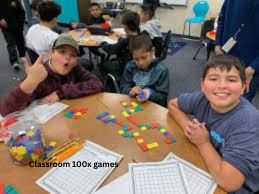Introduction
Classroom 100x games are rapidly gaining popularity in modern education settings. These innovative, fast-paced games are designed to engage students in active learning, foster critical thinking, and reinforce classroom concepts in a fun and interactive way. Whether you’re a teacher looking to energize your lessons or a student searching for exciting classroom activities, 100x games offer a fresh take on traditional learning.
In this article, we’ll explore what classroom 100x games are, why they’re effective, and how you can implement them to make your lessons 100 times more exciting. You’ll also find examples, tips, and tools to get started right away.
What Are Classroom 100x Games?
Classroom 100x games are educational activities structured to be fast, repeatable, and highly engaging. The “100x” concept refers to amplifying the impact of learning—making lessons more memorable, dynamic, and interactive. These games often combine competition, collaboration, and creativity, helping students retain information while having fun.
They can be digital or offline, individual or group-based, and adaptable for all grade levels. The common theme across all 100x games is maximizing participation and educational value within a short time.
Why Use 100x Games in the Classroom?
H3: Improves Student Engagement
Students are more likely to pay attention and participate when learning feels like a game. The excitement and competition of 100x games can turn even the most passive learners into active contributors.
H3: Enhances Knowledge Retention
Games often involve repetition, problem-solving, and instant feedback—all of which improve memory and comprehension.
H3: Encourages Teamwork and Social Skills
Many 100x games are team-based, encouraging communication, cooperation, and leadership skills among students.
H3: Adaptable for Any Subject
From math to language arts, history to science, you can tailor Classroom 100x games to fit any topic or curriculum goal.
Top Classroom 100x Games to Try
H3: 1. Quiz Race
Divide the class into teams and ask rapid-fire questions. Each correct answer moves the team forward on a digital or physical game board. The first to reach the finish wins!
Best for: Reviewing facts, vocabulary, or math problems.
H3: 2. 100x Kahoot Challenges
Use platforms like Kahoot! to create time-limited quizzes with increasing difficulty. Add a leaderboard to track progress over the semester.
Pro tip: Rotate student quiz masters weekly for added engagement.
H3: 3. Speed Stations
Set up learning stations around the classroom. Students rotate every few minutes to complete tasks, puzzles, or mini-games.
Great for: Hands-on learning and group collaboration.
H3: 4. 100-Second Countdown
Give students exactly 100 seconds to complete a task—solving a math equation, writing a sentence, or identifying key concepts. It adds pressure in a fun way and keeps them focused.
Use for: Bell ringers or exit tickets.
H3: 5. Flashcard Faceoff
Use digital or physical flashcards. Students face off 1v1, and the winner continues. This keeps the classroom energy high and reinforces content quickly.
How to Implement 100x Games Effectively
H3: Align With Learning Objectives
Ensure the game supports the lesson’s goals. Don’t play just for fun—play with a purpose.
H3: Keep It Simple and Scalable
Start with basic formats and expand. Complicated rules can be a distraction and reduce effectiveness.
H3: Balance Competition and Inclusion
Encourage participation from all students. Consider random teams and rules that prevent the same students from always winning.
H3: Collect Feedback
Ask students what they liked, what confused them, and how to make the game better next time.
Tools and Resources for Creating Classroom 100x Games
H3: Digital Tools
- Kahoot! – Great for quizzes and interactive games
- Blooket – Combines gaming with learning content
- Quizizz – Offers self-paced and live quiz options
- ClassDojo – Gamifies classroom behavior and goals
H3: Offline Resources
- Printable game boards
- Dry-erase cards
- DIY flashcards
- Timers and buzzers
Benefits Backed by Research
Studies have shown that game-based learning can increase test scores, motivation, and student satisfaction. According to Edutopia, classrooms that incorporate interactive play and digital games report higher levels of student achievement and classroom engagement.
Additionally, the American Psychological Association notes that when students enjoy the process of learning, their ability to retain information increases significantly.
Conclusion
Classroom 100x games are more than just a trend—they’re a transformative approach to teaching. By incorporating these high-energy, purpose-driven games into your lesson plans, you can boost engagement, deepen understanding, and create a classroom environment where students love to learn.
Whether you’re just starting or looking to level up your existing methods, the tips and examples in this guide can help you make your classroom 100x better.

